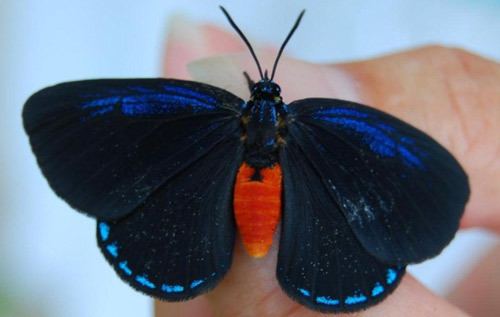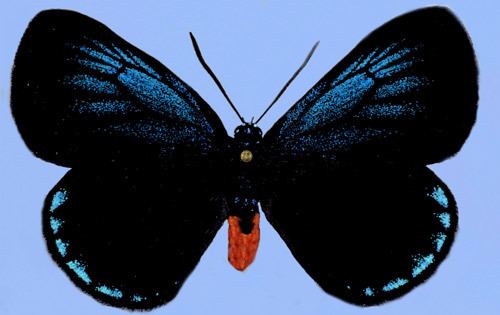Scientific name Eumaeus atala Rank Species | Genus Eumaeus Order Butterflies and moths | |
 | ||
Similar Eumaeus, Zamia integrifolia, Strymon acis, Zamia pumila, Theclinae | ||
Coontie hairstreak butterfly eumaeus atala on zamia
Eumaeus atala, the Atala or coontie hairstreak, is a small colorful butterfly in the family Lycaenidae. It is found in southeastern Florida, the Bahamas, Cuba, the Cayman Islands, and probably on other Caribbean islands. Its coloration and habits are unique among butterflies within its range.

The Atala is a great example of aposematic (warning) coloration throughout its life cycle. The brightly colored larva or caterpillar feeds on cycads which contain a toxic secondary plant chemical (cycasin) which it retains in its body for life. Birds, lizards, and other animals may attempt to prey on the larva, pupa, and adults, but find them distasteful and learn to avoid these brightly patterned insects. In Florida, the larvae feed on a native cycad, Zamia pumila, called coontie, as well as introduced ornamental cycads. In Cuba, the cycad Cycas revoluta is eaten.

Adult butterflies take flower nectar and sometimes roost in trees. Adults fly through much of the year. The natural habitat is open brushy areas and subtropical hammocks, often in pine woodlands. Many populations now exist in suburban areas with ornamental cycads. Adults keep close to a site with host plants, thus the species forms small colonies. The females, however, may disperse in search of more hosts. The butterfly's flight is slow, unlike the swift, erratic flight of many other Lycaenidae. Like many Lepidoptera, male Atalas have hair-pencils (coremata) on their abdomens used in courtship—the male hovers in front of the female, wafting pheromones exuded from the pencils in her direction. Eggs are laid in clusters of 10-50 on the leaf tips of the host plant. Larvae feed on the leaves. Pupation is usually on the host plant.

The Florida subspecies of this butterfly (Eumaeus atala florida) was at one time believed to have become extinct due to over harvest of its host plant, coontie. It was not collected in Florida from 1937 until 1959. The Atala is now common locally in southeast Florida rebounding to some extent as it has begun to use ornamental cycads planted in suburban areas. In Palm Springs, Florida, the G-Star School of the Arts has been contributing the regrowth of the subspecies.

The species was originally described by the Cuban zoologist Felipe Poey. He named the butterfly for Atala, the Native American heroine of an 1801 French novella by Chateaubriand, Atala, ou Les Amours de deux sauvages dans le desert.

